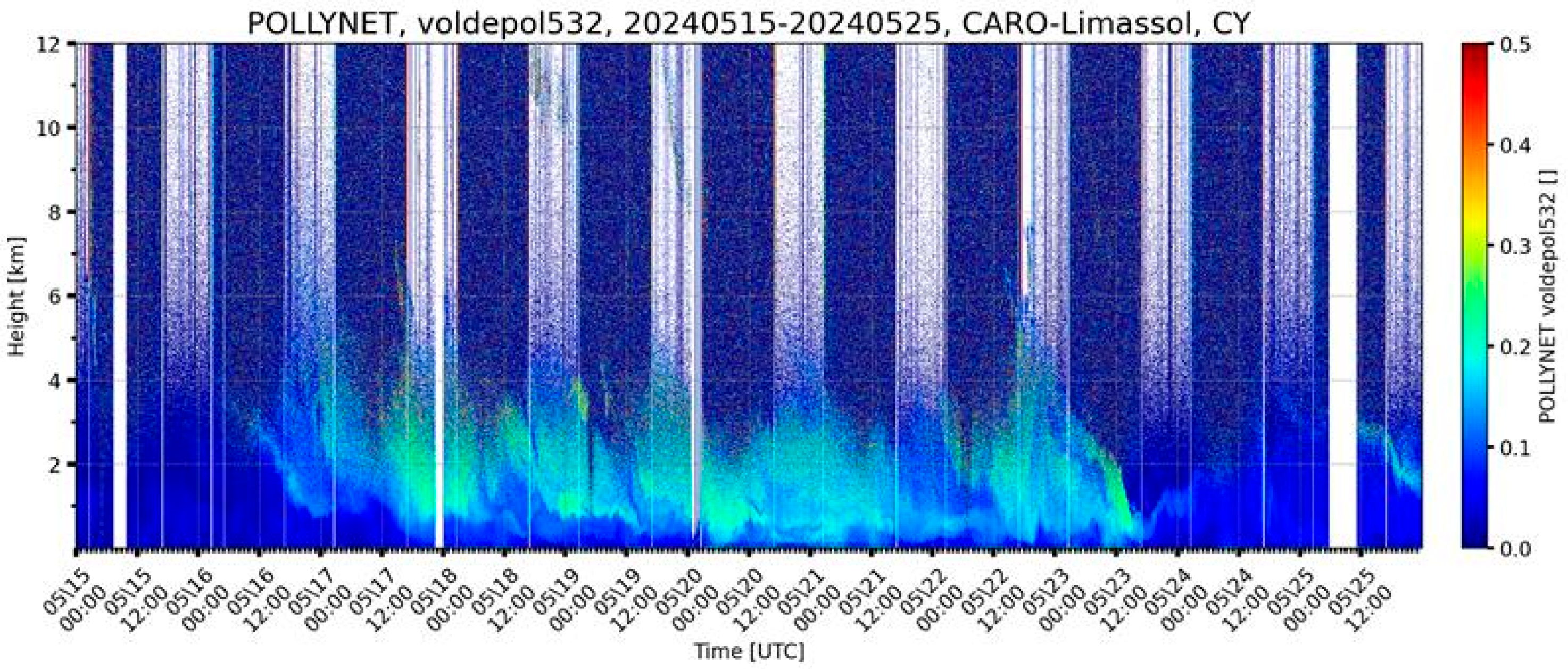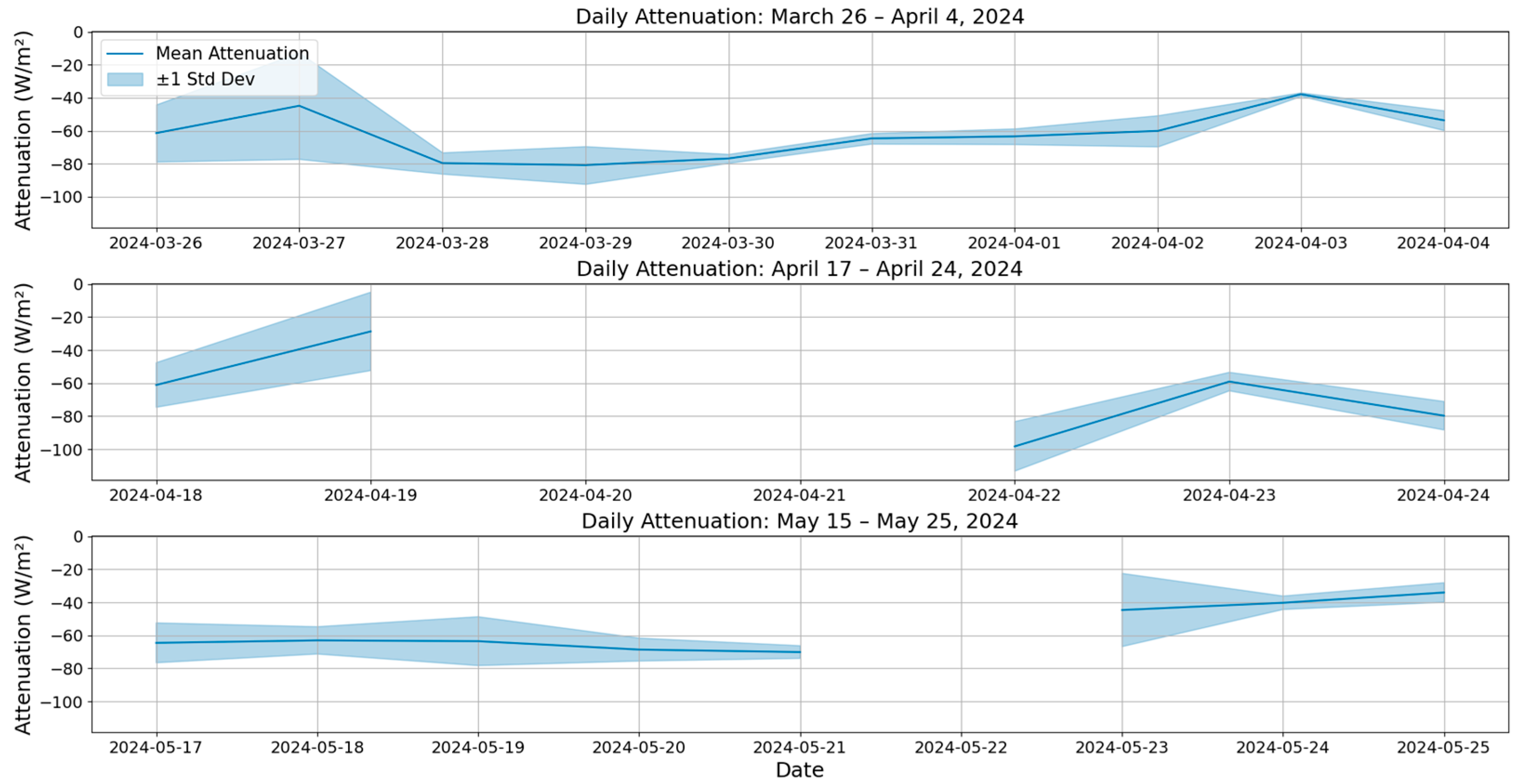Direct Radiative Effects of Dust Events over Limassol, Cyprus in 2024 Using Ground-Based Measurements and Modelling †
Abstract
1. Introduction
2. Data and Methodology
3. Results and Discussion
3.1. Model Evaluation
3.2. Daily Radiative Attenuation During Dust Events
4. Conclusions
Author Contributions
Funding
Institutional Review Board Statement
Informed Consent Statement
Data Availability Statement
Acknowledgments
Conflicts of Interest
References
- Bellouin, N.; Quaas, J.; Gryspeerdt, E.; Kinne, S.; Stier, P.; Watson-Parris, D.; Boucher, O.; Carslaw, K.S.; Christensen, M.; Daniau, A.-L.; et al. Bounding Global Aerosol Radiative Forcing of Climate Change. Rev. Geophys. 2020, 58, e2019RG000660. [Google Scholar] [CrossRef] [PubMed]
- Sokolik, I.N.; Winker, D.M.; Bergametti, G.; Gillette, D.A.; Carmichael, G.; Kaufman, Y.J.; Gomes, L.; Schuetz, L.; Penner, J.E. Introduction to special section: Outstanding problems in quantifying the radiative impacts of mineral dust. J. Geophys. Res. Atmos. 2001, 106, 18015–18027. [Google Scholar] [CrossRef]
- Fountoulakis, I.; Kosmopoulos, P.; Papachristopoulou, K.; Raptis, I.-P.; Mamouri, R.-E.; Nisantzi, A.; Gkikas, A.; Witthuhn, J.; Bley, S.; Moustaka, A.; et al. Effects of Aerosols and Clouds on the Levels of Surface Solar Radiation and Solar Energy in Cyprus. Remote Sens. 2021, 13, 2319. [Google Scholar] [CrossRef]
- Kok, J.F.; Storelvmo, T.; Karydis, V.A.; Adebiyi, A.A.; Mahowald, N.M.; Evan, A.T.; He, C.; Leung, D.M. Mineral dust aerosol impacts on global climate and climate change. Nat. Rev. Earth Environ. 2023, 4, 71–86. [Google Scholar] [CrossRef]
- Boucher, O.; Randall, D.; Artaxo, P.; Bretherton, C.; Feingold, G.; Forster, P.; Kerminen, V.-M.; Kondo, Y.; Liao, H.; Lohmann, U.; et al. Clouds and Aerosols. In Climate Change 2013—The Physical Science Basis; Cambridge University Press: Cambridge, UK, 2013; pp. 571–658. [Google Scholar] [CrossRef]
- Achilleos, S.; Mouzourides, P.; Kalivitis, N.; Katra, I.; Kloog, I.; Kouis, P.; Middleton, N.; Mihalopoulos, N.; Neophytou, M.; Panayiotou, A.; et al. Spatio-temporal variability of desert dust storms in Eastern Mediterranean (Crete, Cyprus, Israel) between 2006 and 2017 using a uniform methodology. Sci. Total Environ. 2020, 714, 136693. [Google Scholar] [CrossRef] [PubMed]
- Ene, D.; Poutli, M.; Mettas, C.; Michaelides, S.; Mamouri, R.-E.; Nisantzi, A.; Papoutsa, C.; Hadjimitsis, D.; Bühl, J.; Seifert, P. Aerosol and Cloud Remote Sensing Observation in Limassol, Cyprus. In Proceedings of the 2024 IEEE International Symposium on Geoscience and Remote Sensing (IGARSS 2024), Athens, Greece, 7–12 July 2024; pp. 3111–3114. [Google Scholar] [CrossRef]
- Fragkos, K.; Nisantzi, A.; Fountoulakis, I.; Michaelides, S.; Charalampous, G.; Papachristopoulou, K.; Kontoes, C.; Hadjimitsis, D.; Kazadzis, S. Introducing the Solar Radiation and Energy Laboratory of the Eratosthenes’ Centre of Excellence: Overview of Activities. Environ. Sci. Proc. 2023, 26, 45. [Google Scholar] [CrossRef]
- Mamouri, R.-E.; Ansmann, A.; Nisantzi, A.; Solomos, S.; Kallos, G.; Hadjimitsis, D.G. Extreme dust storm over the eastern Mediterranean in September 2015: Satellite, lidar, and surface observations in the Cyprus region. Atmos. Meas. Tech. 2016, 16, 13711–13724. [Google Scholar] [CrossRef]
- Logothetis, S.-A.; Salamalikis, V.; Gkikas, A.; Kazadzis, S.; Amiridis, V.; Kazantzidis, A. 15-year variability of desert dust optical depth on global and regional scales. Atmos. Meas. Tech. 2021, 21, 16499–16529. [Google Scholar] [CrossRef]
- Gkikas, A.; Obiso, V.; García-Pando, C.P.; Jorba, O.; Hatzianastassiou, N.; Vendrell, L.; Basart, S.; Solomos, S.; Gassó, S.; Baldasano, J.M. Direct radiative effects during intense Mediterranean desert dust outbreaks. Atmos. Meas. Tech. 2018, 18, 8757–8787. [Google Scholar] [CrossRef]
- Giles, D.M.; Sinyuk, A.; Sorokin, M.G.; Schafer, J.S.; Smirnov, A.; Slutsker, I.; Eck, T.F.; Holben, B.N.; Lewis, J.R.; Campbell, J.R.; et al. Advancements in the Aerosol Robotic Network (AERONET) Version 3 database—Automated near-real-time quality control algorithm with improved cloud screening for Sun photometer aerosol optical depth (AOD) measurements. Atmos. Meas. Tech. 2019, 12, 169–209. [Google Scholar] [CrossRef]
- Barnes, W.; Xiong, X.; Salomonson, V. Status of terra MODIS and aqua modis. Adv. Space Res. 2003, 32, 2099–2106. [Google Scholar] [CrossRef]
- Levelt, P.F.; Joiner, J.; Tamminen, J.; Veefkind, J.P.; Bhartia, P.K.; Zweers, D.C.S.; Duncan, B.N.; Streets, D.G.; Eskes, H.; Van Der A, R.; et al. The Ozone Monitoring Instrument: Overview of 14 years in space. Atmos. Chem. Phys. 2018, 18, 5699–5745. [Google Scholar] [CrossRef]
- Stein, A.F.; Draxler, R.R.; Rolph, G.D.; Stunder, B.J.B.; Cohen, M.D.; Ngan, F. NOAA’s HYSPLIT Atmospheric Transport and Dispersion Modeling System. Bull. Am. Meteorol. Soc. 2015, 96, 2059–2077. [Google Scholar] [CrossRef]
- Dubovik, O.; Holben, B.; Eck, T.F.; Smirnov, A.; Kaufman, Y.J.; King, M.D.; Tanré, D.; Slutsker, I. Variability of Absorption and Optical Properties of Key Aerosol Types Observed in Worldwide Locations. J. Atmos. Sci. 2002, 59, 590–608. [Google Scholar] [CrossRef]
- Emde, C.; Buras-Schnell, R.; Kylling, A.; Mayer, B.; Gasteiger, J.; Hamann, U.; Kylling, J.; Richter, B.; Pause, C.; Dowling, T.; et al. The libRadtran software package for radiative transfer calculations (version 2.0.1). Geosci. Model Dev. 2016, 9, 1647–1672. [Google Scholar] [CrossRef]
- Mayer, B.; Kylling, A. Technical note: The libRadtran software package for radiative transfer calculations—Description and examples of use. Atmos. Chem. Phys. 2005, 5, 1855–1877. [Google Scholar] [CrossRef]





| Event 1 | AOD_500nm | 440–870_Angstrom_Exponent | ||
| mean | std | mean | std | |
| Date | ||||
| 2024-03-26 | 0.415 | 0.054 | 0.254 | 0.061 |
| 2024-03-27 | 0.294 | 0.036 | 0.231 | 0.013 |
| 2024-03-28 | 0.448 | 0.066 | 0.191 | 0.021 |
| 2024-03-29 | 0.486 | 0.030 | 0.236 | 0.052 |
| 2024-03-30 | 0.372 | 0.029 | 0.350 | 0.082 |
| 2024-03-31 | 0.280 | 0.007 | 0.382 | 0.018 |
| 2024-04-01 | 0.269 | 0.014 | 0.425 | 0.056 |
| 2024-04-02 | 0.241 | 0.029 | 0.498 | 0.038 |
| 2024-04-03 | 0.172 | 0.026 | 0.584 | 0.148 |
| 2024-04-04 | 0.271 | 0.115 | 0.282 | 0.079 |
| Event 2 | AOD_500nm | 440–870_Angstrom_Exponent | ||
| mean | std | mean | std | |
| Date | ||||
| 2024-04-17 | 0.134 | 0.032 | 0.845 | 0.114 |
| 2024-04-18 | 0.351 | 0.097 | 0.246 | 0.064 |
| 2024-04-19 | 0.214 | 0.063 | 0.543 | 0.132 |
| 2024-04-20 | ||||
| 2024-04-21 | ||||
| 2024-04-22 | 0.611 | 0.159 | 0.186 | 0.024 |
| 2024-04-23 | 0.379 | 0.017 | 0.204 | 0.017 |
| 2024-04-24 | 0.531 | 0.021 | 0.207 | 0.013 |
| 2024-04-25 | ||||
| 2024-04-26 | ||||
| 2024-04-27 | ||||
| 2024-04-28 | 0.277 | 0.022 | 0.339 | 0.024 |
| Event 3 | AOD_500nm | 440–870_Angstrom_Exponent | ||
| mean | std | mean | std | |
| Date | ||||
| 2024-05-15 | 0.142 | 0.036 | 1.315 | 0.110 |
| 2024-05-16 | 0.150 | 0.024 | 1.172 | 0.173 |
| 2024-05-17 | 0.400 | 0.051 | 0.311 | 0.041 |
| 2024-05-18 | 0.372 | 0.049 | 0.248 | 0.047 |
| 2024-05-19 | 0.464 | 0.049 | 0.289 | 0.048 |
| 2024-05-20 | 0.413 | 0.022 | 0.314 | 0.069 |
| 2024-05-21 | 0.399 | 0.016 | 0.400 | 0.057 |
| 2024-05-22 | ||||
| 2024-05-23 | 0.276 | 0.103 | 0.273 | 0.068 |
| 2024-05-24 | 0.166 | 0.015 | 0.776 | 0.075 |
| 2024-05-25 | 0.205 | 0.044 | 0.927 | 0.127 |
Disclaimer/Publisher’s Note: The statements, opinions and data contained in all publications are solely those of the individual author(s) and contributor(s) and not of MDPI and/or the editor(s). MDPI and/or the editor(s) disclaim responsibility for any injury to people or property resulting from any ideas, methods, instructions or products referred to in the content. |
© 2025 by the authors. Licensee MDPI, Basel, Switzerland. This article is an open access article distributed under the terms and conditions of the Creative Commons Attribution (CC BY) license (https://creativecommons.org/licenses/by/4.0/).
Share and Cite
Charalampous, G.; Fragkos, K.; Fountoulakis, I.; Papachristopoulou, K.; Nisantzi, A.; Mamouri, R.-E.; Hadjimitsis, D.; Kazadzis, S. Direct Radiative Effects of Dust Events over Limassol, Cyprus in 2024 Using Ground-Based Measurements and Modelling. Environ. Earth Sci. Proc. 2025, 35, 77. https://doi.org/10.3390/eesp2025035077
Charalampous G, Fragkos K, Fountoulakis I, Papachristopoulou K, Nisantzi A, Mamouri R-E, Hadjimitsis D, Kazadzis S. Direct Radiative Effects of Dust Events over Limassol, Cyprus in 2024 Using Ground-Based Measurements and Modelling. Environmental and Earth Sciences Proceedings. 2025; 35(1):77. https://doi.org/10.3390/eesp2025035077
Chicago/Turabian StyleCharalampous, Georgia, Konstantinos Fragkos, Ilias Fountoulakis, Kyriakoula Papachristopoulou, Argyro Nisantzi, Rodanthi-Elisavet Mamouri, Diofantos Hadjimitsis, and Stelios Kazadzis. 2025. "Direct Radiative Effects of Dust Events over Limassol, Cyprus in 2024 Using Ground-Based Measurements and Modelling" Environmental and Earth Sciences Proceedings 35, no. 1: 77. https://doi.org/10.3390/eesp2025035077
APA StyleCharalampous, G., Fragkos, K., Fountoulakis, I., Papachristopoulou, K., Nisantzi, A., Mamouri, R.-E., Hadjimitsis, D., & Kazadzis, S. (2025). Direct Radiative Effects of Dust Events over Limassol, Cyprus in 2024 Using Ground-Based Measurements and Modelling. Environmental and Earth Sciences Proceedings, 35(1), 77. https://doi.org/10.3390/eesp2025035077








